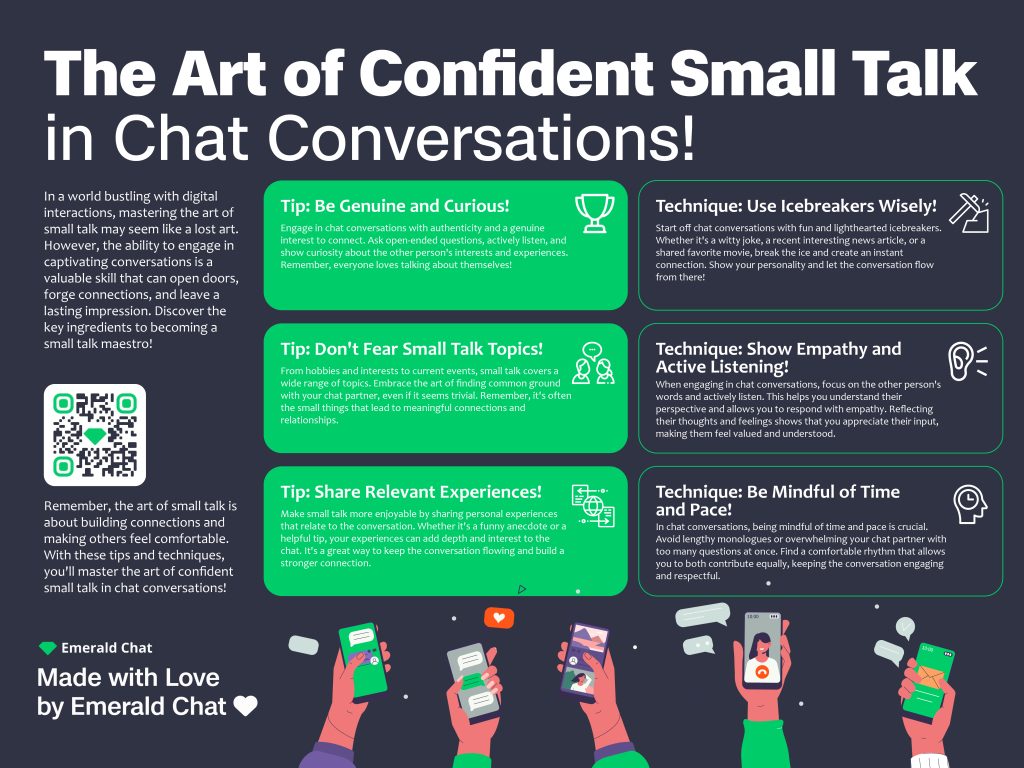Effective communication is a vital skill that plays a crucial role in both personal and professional settings. It is the foundation for building strong relationships, resolving conflicts, and achieving success in various aspects of life. Whether it’s expressing our thoughts and ideas, listening to others, or understanding nonverbal cues, effective communication is essential for conveying messages accurately and avoiding misunderstandings. Even in the context of random chat platforms, effective communication can lead to more meaningful interactions. In this article, we will explore the importance of effective communication and provide tips and strategies for improving communication skills in different contexts.
Understanding the Importance of Effective Communication
Effective communication is crucial for success in personal and professional settings. In personal relationships, it helps us express our feelings, needs, and desires, fostering understanding and connection with others. In professional settings, effective communication is essential for collaboration, teamwork, and achieving common goals. It enables us to convey information clearly, listen actively to others’ perspectives, and build strong relationships with colleagues and clients.
On the other hand, poor communication can lead to misunderstandings and conflicts. Miscommunication can result in confusion, frustration, and even damage relationships. For example, if a manager fails to communicate expectations clearly to their team members, it can lead to confusion and a lack of productivity. Similarly, in personal relationships, miscommunication can lead to hurt feelings, resentment, and breakdowns in trust.
Identifying Communication Barriers and How to Overcome Them
Several common barriers to effective communication can hinder understanding and create misunderstandings. These barriers include language barriers, cultural differences, distractions, lack of attention or interest, and emotional barriers. It is essential to recognize these barriers to overcome them and improve communication.
One strategy for overcoming communication barriers is active listening. Active listening involves fully focusing on the speaker, paying attention to both verbal and nonverbal cues, and providing feedback to ensure understanding. By actively listening, we can better understand the speaker’s message and respond appropriately.
Another strategy is asking clarifying questions. If we are unsure about something, it is crucial to ask for clarification rather than making assumptions. This helps to ensure that we clearly understand the message being conveyed and reduces the chances of misunderstandings.
Developing Active Listening Skills for Better Communication
Active listening is a crucial skill for effective communication. It involves fully engaging with the speaker, paying attention to both verbal and nonverbal cues, and providing feedback to ensure understanding. By actively listening, we can better understand the speaker’s message, show respect and empathy, and respond appropriately.
To improve active listening skills, it is important to maintain eye contact with the speaker. This shows that we are fully engaged and interested in what they have to say. Additionally, avoiding distractions such as checking our phones or thinking about other things can help us stay focused on the conversation.
Another tip for active listening is to avoid interrupting the speaker. It is important to let them finish their thoughts before responding or asking questions. Interrupting can disrupt the flow of the conversation and make the speaker feel unheard or disrespected.
The Power of Nonverbal Communication and Body Language
Nonverbal communication plays a significant role in effective communication. It includes facial expressions, body language, gestures, and tone of voice. In fact, research suggests that nonverbal cues can convey more meaning than verbal communication alone.
To use body language effectively, it is important to maintain good posture and open body language. This shows that we are approachable and interested in the conversation. Additionally, using appropriate facial expressions can help convey our emotions and intentions accurately.
It is also important to be aware of our own nonverbal cues and how they may be perceived by others. For example, crossing our arms may signal defensiveness or disinterest, while maintaining open body language can convey openness and engagement.
Tips for Writing Effective Emails and Memos
In today’s digital age, written communication, such as emails and memos, is a common form of communication in both personal and professional settings. Writing clear and concise messages is essential for effective communication.
When writing emails and memos, it is important to be clear and to the point. Avoid using jargon or technical terms that may not be understood by the recipient. Instead, use simple and straightforward language to convey your message.
Another tip is to organize your thoughts before writing. Start with a clear introduction, followed by the main points, and end with a concise conclusion or call to action. This helps the recipient understand the purpose of the message and makes it easier for them to respond or take appropriate action.
It is also important to proofread your emails and memos before sending them. Check for any grammatical or spelling errors, and ensure that the message is clear and easy to understand. Taking the time to review your written communication can help avoid misunderstandings and ensure effective communication.
Mastering the Art of Small Talk

Small talk may seem trivial, but it plays a vital role in building relationships and establishing rapport with others. It helps break the ice, create a comfortable atmosphere, and find common ground with others.
To make small talk effectively, it is important to ask open-ended questions. Open-ended questions encourage the other person to share more about themselves and their interests, leading to a more engaging conversation. For example, instead of asking, “Did you have a good weekend?” ask, “What did you do over the weekend?”.
Finding common ground is another key aspect of small talk. Look for shared interests or experiences that you can discuss with the other person. This helps create a connection and makes the conversation more enjoyable for both parties.
It is also essential to be an active listener during small talk. Show genuine interest in what the other person is saying, maintain eye contact, and provide feedback to show that you are engaged in the conversation. This helps build rapport and fosters a positive connection with others.
Building Strong Relationships through Effective Communication
Effective communication is essential for building strong relationships. It helps establish trust, respect, and understanding between individuals. When communication is open, honest, and transparent, it creates a foundation for healthy and meaningful relationships.
Good communication involves active listening, empathy, and clear expression of thoughts and feelings. By actively listening to others, we show that we value their perspective and are willing to understand their point of view. This fosters trust and respect in the relationship.
Empathy is also crucial for effective communication. Empathy involves putting ourselves in the other person’s shoes and acknowledging their feelings and experiences. By practicing empathy, we can better understand the emotions and needs of others, leading to more meaningful and compassionate communication.
When communication is open and transparent, it allows individuals to express their thoughts, feelings, and needs honestly. This creates an environment where both parties feel heard and understood, leading to stronger relationships built on trust and respect.
The Role of Empathy in Effective Communication
Empathy plays a vital role in effective communication. It involves understanding and acknowledging the emotions and experiences of others. By practicing empathy, we can better understand the needs and perspectives of others, leading to more meaningful and compassionate communication.
To practice empathy, it is important to put ourselves in the other person’s shoes. Try to imagine how they might be feeling or what they might be experiencing. This helps us gain a deeper understanding of their emotions and allows us to respond with empathy and compassion.
Another tip for practicing empathy is to actively listen to the other person. Pay attention to both their verbal and nonverbal cues, and provide feedback to show that you are engaged in the conversation. This helps create a safe and supportive environment for open communication.
It is also important to acknowledge the feelings of others. Validate their emotions and let them know that you understand and empathize with their experiences. This helps build trust and fosters a deeper connection in the communication.
Overcoming Communication Challenges in a Multicultural Workplace
In a multicultural workplace, communication challenges can arise due to cultural differences. Different cultures have different communication styles, norms, and expectations. It is important to be aware of these differences and adapt our communication accordingly to ensure effective communication.
One strategy for overcoming communication challenges in a multicultural workplace is to be aware of cultural norms. Educate yourself about the cultural backgrounds of your colleagues and learn about their communication styles and preferences. This helps avoid misunderstandings and promotes effective communication.
Avoid making assumptions based on cultural stereotypes. Instead, approach each individual as an individual and be open to learning about their unique perspectives and experiences. This helps create an inclusive and respectful environment for communication.
Another tip is to use clear and simple language when communicating with colleagues from different cultural backgrounds. Avoid using jargon or technical terms that may not be understood by everyone. Instead, use plain language to convey your message clearly and effectively.
Strategies for Conflict Resolution through Effective Communication
Effective communication plays a crucial role in resolving conflicts. It helps individuals express their needs and concerns, listen to others’ perspectives, and find common ground for resolution. By using effective communication strategies, conflicts can be resolved in a respectful and constructive manner.
One strategy for conflict resolution is using “I” statements. Instead of blaming or accusing the other person, focus on expressing your own feelings and needs. For example, instead of saying “You always interrupt me”, say “I feel frustrated when I am interrupted”.
Finding common ground is another important aspect of conflict resolution. Look for areas of agreement or shared interests that can serve as a starting point for finding a solution. By focusing on common goals, it becomes easier to work together towards resolution.
Active listening is also crucial for resolving conflicts. By actively listening to the other person’s perspective, you show that you value their point of view and are willing to understand their needs. This helps create a safe and supportive environment for open communication and resolution.
Conclusion
Effective communication is a vital skill that plays a crucial role in both personal and professional settings. It is the foundation for building strong relationships, resolving conflicts, and achieving success in various aspects of life. By understanding the importance of effective communication and implementing strategies such as active listening, empathy, and clear expression, we can improve our communication skills and foster meaningful connections with others.



Leave a Reply